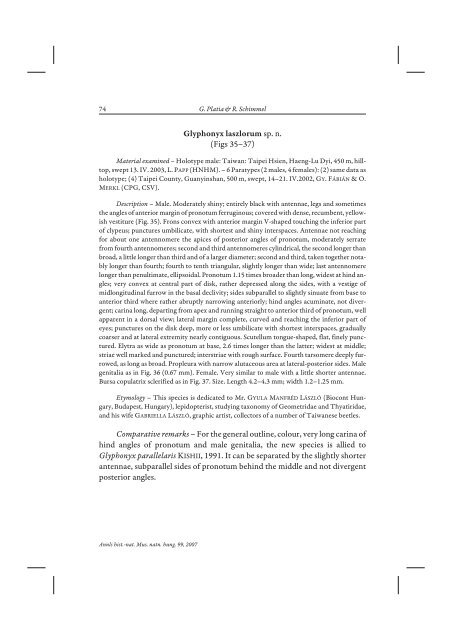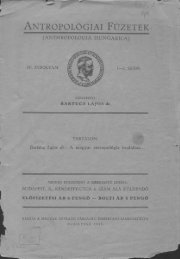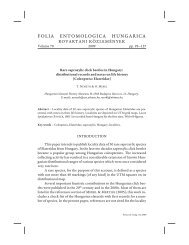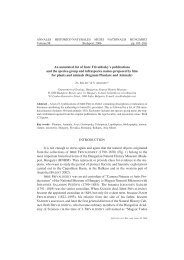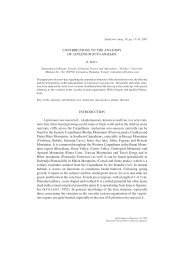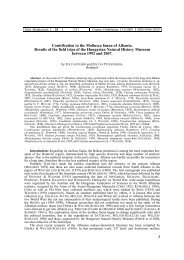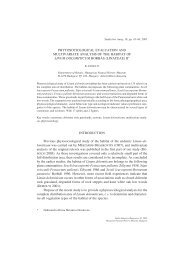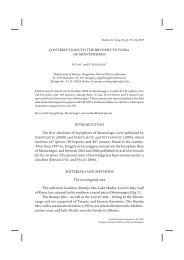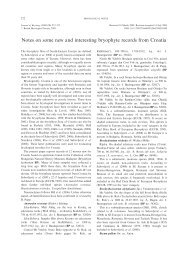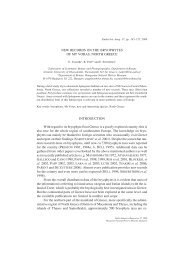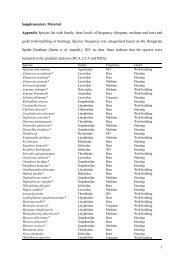Create successful ePaper yourself
Turn your PDF publications into a flip-book with our unique Google optimized e-Paper software.
74 G. Platia & R. SchimmelGlyphonyx laszlorum sp. n.(Figs 35–37)Material exam<strong>in</strong>ed – Holotype male: Taiwan: Taipei Hsien, Haeng-Lu Dyi, 450 m, hilltop,swept 13. IV. 2003, L. PAPP (HNHM). – 6 Paratypes (2 males, 4 females): (2) same data asholotype; (4) Taipei County, Guany<strong>in</strong>shan, 500 m, swept, 14–21. IV.2002, GY.FÁBIÁN &O.MERKL (CPG, CSV).Description – Male. Moderately sh<strong>in</strong>y; entirely black with antennae, legs and sometimesthe angles of anterior marg<strong>in</strong> of pronotum ferrug<strong>in</strong>ous; covered with dense, recumbent, yellowishvestiture (Fig. 35). Frons convex with anterior marg<strong>in</strong> V-shaped touch<strong>in</strong>g the <strong>in</strong>ferior partof clypeus; punctures umbilicate, with shortest and sh<strong>in</strong>y <strong>in</strong>terspaces. Antennae not reach<strong>in</strong>gfor about one antennomere the apices of posterior angles of pronotum, moderately serratefrom fourth antennomeres; second and third antennomeres cyl<strong>in</strong>drical, the second longer thanbroad, a little longer than third and of a larger diameter; second and third, taken together notablylonger than fourth; fourth to tenth triangular, slightly longer than wide; last antennomerelonger than penultimate, ellipsoidal. Pronotum 1.15 times broader than long, widest at h<strong>in</strong>d angles;very convex at central part of disk, rather depressed along the sides, with a vestige ofmidlongitud<strong>in</strong>al furrow <strong>in</strong> the basal declivity; sides subparallel to slightly s<strong>in</strong>uate from base toanterior third where rather abruptly narrow<strong>in</strong>g anteriorly; h<strong>in</strong>d angles acum<strong>in</strong>ate, not divergent;car<strong>in</strong>a long, depart<strong>in</strong>g from apex and runn<strong>in</strong>g straight to anterior third of pronotum, wellapparent <strong>in</strong> a dorsal view; lateral marg<strong>in</strong> complete, curved and reach<strong>in</strong>g the <strong>in</strong>ferior part ofeyes; punctures on the disk deep, more or less umbilicate with shortest <strong>in</strong>terspaces, graduallycoarser and at lateral extremity nearly contiguous. Scutellum tongue-shaped, flat, f<strong>in</strong>ely punctured.Elytra as wide as pronotum at base, 2.6 times longer than the latter; widest at middle;striae well marked and punctured; <strong>in</strong>terstriae with rough surface. Fourth tarsomere deeply furrowed,as long as broad. Propleura with narrow alutaceous area at lateral-posterior sides. Malegenitalia as <strong>in</strong> Fig. 36 (0.67 mm). Female. Very similar to male with a little shorter antennae.Bursa copulatrix sclerified as <strong>in</strong> Fig. 37. Size. Length 4.2–4.3 mm; width 1.2–1.25 mm.Etymology – This species is dedicated to Mr. GYULA MANFRÉD LÁSZLÓ (Biocont Hungary,Budapest, Hungary), lepidopterist, study<strong>in</strong>g taxonomy of Geometridae and Thyatiridae,and his wife GABRIELLA LÁSZLÓ, graphic artist, collectors of a number of Taiwanese beetles.Comparative remarks – For the general outl<strong>in</strong>e, colour, very long car<strong>in</strong>a ofh<strong>in</strong>d angles of pronotum and male genitalia, the new species is allied toGlyphonyx parallelaris KISHII, 1991. It can be separated by the slightly shorterantennae, subparallel sides of pronotum beh<strong>in</strong>d the middle and not divergentposterior angles.Annls hist.-nat. Mus. natn. hung. 99, 2007


